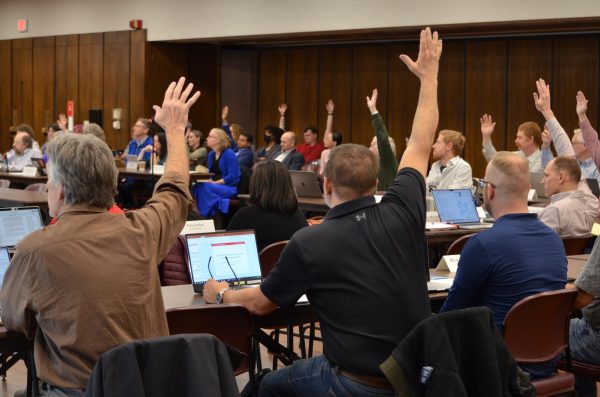City of Ames receives community input on next fiscal budget
City Manager Steve Schainker was responsible for writing what those in attendance believed should receive more or less funding.
The city of Ames hosted the annual Town Budget Meeting Tuesday evening, giving community members an opportunity to give their opinions on the city’s upcoming budget.
Those in attendance were asked to give feedback as to what the city should spend more or less on, with some community members also praising the city for the services they provide to the community.
Assistant City Manager and interim Finance Director Brian Phillips and Budget Manager Nancy Masteller presented a slideshow detailing some of the city’s expenses.
“The city’s only a portion of [the Ames property tax]; it’s about a third, and the rest of your tax rate is made up by the school district, which is the largest percentage,” Masteller said.
Based on the current tax rates, the city makes up 32.02%, with the Ames School District making up 46.53%. The rest of the sum is made up of 19.19% going toward the county and 2.26% going toward Des Moines Area Community College.
While sharing the various sources of the cities revenue, Masteller and Phillips shared that the largest source of revenue for the fiscal year 2022-2023 has been from charges for service, which raked in $96,918,484, followed by property taxes which has brought the city $34,960,013.
With a grand total before transfers of $267,945,995, the city’s sources of revenue are ranked in descending order:
— Intergovernmental revenue: $33,235,333
— Transfers: $23,906,999
— Miscellaneous revenue: $21,150,259
— Internal service revenue: $21,076,142
— Proceeds from bonds: $18,359,410
— Other taxes: $12,528,750
— Use of money and property: $3,620,515
— Licenses and permits: $1,681,190
— Fines, forfeit and penalty: $508,900
Regarding spending city funds, 29.6% of the revenue is spent to address utility costs, and 29.3% goes towards capital improvement plans. The rest of the revenue is spent on public safety, which makes up 10.1% of expenses, transportation which makes up 8.6%, 8% toward internal services, 6.9% for debt services, 4.1% for cultural and recreational endeavors, 2.6% for general governmental proceedings and 2.4% for community development.
From those in attendance, City Manager Steve Schainker compiled a list of things that community members believe should receive more funding, including affordable housing, animal control, making the city more accessible for pedestrians and funding for humanitarian services such as shelters separate from the Analysis of Social Services Evaluation Team (ASSET).
A retired 20-year resident of Ames, Stanley Rabe, said he had to give credit to the city staff and council for how they have been managing Ames.
“Ames is a place that people move back to,” Rabe said, “and I think they move back to it because of the quality of life in this city. So if we were to do more of anything, I think it’s looking at more of those quality of life things that the city offers.”
Grant Olsen has lived and worked in Ames for nine years. He said he believes the city should invest in making walking, biking and transit around Ames more attractive.
“For example, If you’ve ever tried to cross Thackery when using the bike and pedestrian trail, that crossing is a little wide, so just even a few $100 in investment in just shortening that crosswalk — things like that,” Olsen said.
He suggested that the city invest in bike share kiosks to make biking more accessible for those who would bike in Ames but are opposed to owning a bike.
The meeting served as an opportunity for community members to provide input on the upcoming budget, but it is not the last. Final decisions on the budget will be made Jan. 14, 2023. The drafted budget will begin to be revealed Jan. 17, 2023, during a Capital Improvements Planning workshop, which will allow community members to give input again.
Until then, community members can email the city with their thoughts on how the budget is allocated. Organizations seeking allocations from the city to be budgeted for in the next budget have a cutoff date of Dec. 13.
Your donation will support the student journalists of the Iowa State Daily. Your contribution will allow us to purchase equipment, send our student journalists to conferences and off-set their cost of living so they can continue to do best-in-the-nation work at the Iowa State Daily.













